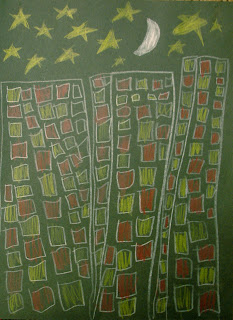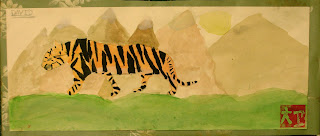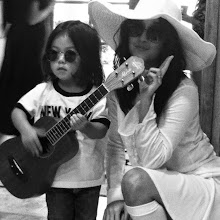Friday, December 4, 2009
UE: Wire Portraits
 Violet
Violet I wanted to teach students how to do portraits in wire because it was a different medium from graphite, but similar in line quality. We first drew our faces while I demonstrated on the board. It was difficult without mirrors, but they used their hands to feel their features and I think it was helpful to draw them as a class. Then, I showed them Alexander Calder's work as inspiration and students sculpted their portraits in wire. As a way to transition from drawing to wire, students traced their portrait with wire (see Violet's in-progress work) while figuring out how to connect them so that it was all in one form. I think they look really Neat! (BTW, students used colorful wire, but the colors came out awful with my camera so I'm showing them b/w).
I wanted to teach students how to do portraits in wire because it was a different medium from graphite, but similar in line quality. We first drew our faces while I demonstrated on the board. It was difficult without mirrors, but they used their hands to feel their features and I think it was helpful to draw them as a class. Then, I showed them Alexander Calder's work as inspiration and students sculpted their portraits in wire. As a way to transition from drawing to wire, students traced their portrait with wire (see Violet's in-progress work) while figuring out how to connect them so that it was all in one form. I think they look really Neat! (BTW, students used colorful wire, but the colors came out awful with my camera so I'm showing them b/w). Alexander Calder
Wednesday, November 25, 2009
LE and UE: Skyscrapers
As a one class lesson before Thanksgiving break, students who were done with their scrolls drew a nighttime or daytime city scene with skyscrapers. They had the option of making up buildings, adding monsters and rocketships, etc, as long as the focus of the drawing were the buildings. I thought LE drawings came out just as well as UE's. I loved the window patterns because they added a cool design element.
Artist Statements for Chinese Animal Painting
 "I did the tiger and it means I am brave. I chose it becaues I am daring. I would probably hang it in my room because my room is a jungul." Desiree
"I did the tiger and it means I am brave. I chose it becaues I am daring. I would probably hang it in my room because my room is a jungul." Desiree "I chose the carp because it symbolizes perseverance and great intelligence. I chose it to express myself because I keep trying at things and I'm really good at math. I would hang it in my room because that's where a lot of books are because I get a lot of information from them."
"I chose the carp because it symbolizes perseverance and great intelligence. I chose it to express myself because I keep trying at things and I'm really good at math. I would hang it in my room because that's where a lot of books are because I get a lot of information from them." "I chose the carp. I chose it because I am doing pretty good in school and I persevere at getting good grades in school. I would hang it over my bed so that every time I go to bed and wake up I can always remember my goals." Sean
"I chose the carp. I chose it because I am doing pretty good in school and I persevere at getting good grades in school. I would hang it over my bed so that every time I go to bed and wake up I can always remember my goals." Sean "I chose the goose because it is orderly and responsible. I think I am orderly because I finish my work and hand it in on time. I enjoyed this project because you get to express yourself and show your feelings." Nicky
"I chose the goose because it is orderly and responsible. I think I am orderly because I finish my work and hand it in on time. I enjoyed this project because you get to express yourself and show your feelings." Nicky "My drawing is of a dragon. I chose this animal because it means good leadership. I think I am a good leader because I am kind, a good role model, and I have great determination. My personality has these things in my personality and I have more fun things too. I would hang this picture in my room because a lot of my friends come in there and always come out looking at one piece of artwork." Brooke
"My drawing is of a dragon. I chose this animal because it means good leadership. I think I am a good leader because I am kind, a good role model, and I have great determination. My personality has these things in my personality and I have more fun things too. I would hang this picture in my room because a lot of my friends come in there and always come out looking at one piece of artwork." Brooke
Thursday, November 19, 2009
UE: Chinese Animal Painting
 Sadie
Sadie Students in upper elementary recently began their study on Ancient China and as a way to tie into their curriculum, I taught a lesson on animal painting, one of the oldest subjects in Chinese art. What's very interesting about this subject is that in Chinese culture, all animals are believed to have specific meanings and roles in the universe. For example, artists often depicted a Chinese ruler or emperor as a dragon, or a soldier ready to fight in battle as a tiger. Students learned what characteristics each one represented and chose an animal they identified with. I provided them with visual references and they sketched it out, painted in tempera, and chose an attractive paper for the background. They also created a seal with their name translated in Chinese. Lastly, I had them write an artist's statement explaining what animal they painted, why they chose it to express themselves, and based on its meaning where they would hang it. This was a fairly long project that I hope improved their drawing and painting skills as well as empower their confidence in themselves. I was very impressed by the attention students devoted to their paintings and their thoughtful written responses.
Students in upper elementary recently began their study on Ancient China and as a way to tie into their curriculum, I taught a lesson on animal painting, one of the oldest subjects in Chinese art. What's very interesting about this subject is that in Chinese culture, all animals are believed to have specific meanings and roles in the universe. For example, artists often depicted a Chinese ruler or emperor as a dragon, or a soldier ready to fight in battle as a tiger. Students learned what characteristics each one represented and chose an animal they identified with. I provided them with visual references and they sketched it out, painted in tempera, and chose an attractive paper for the background. They also created a seal with their name translated in Chinese. Lastly, I had them write an artist's statement explaining what animal they painted, why they chose it to express themselves, and based on its meaning where they would hang it. This was a fairly long project that I hope improved their drawing and painting skills as well as empower their confidence in themselves. I was very impressed by the attention students devoted to their paintings and their thoughtful written responses.Tuesday, October 20, 2009
LE: Hybrid Creatures
 Elizabeth
Elizabeth.jpg) Students are still finishing up their final touches, but I was too excited to wait, so here are samples of finished pieces! As a way to tie in the Zoology theme in lower elementary, students drew and sculpted hybrid creatures. We looked at references of Greek mythological sculptures, a painting that one of my RISD professors had done, and identified the different body parts. Students then drew their own while looking at photos of animals for reference. After giving them a demonstration on modeling and painting, students brought their drawings to life out of clay and painted it with acrylic paint.
Students are still finishing up their final touches, but I was too excited to wait, so here are samples of finished pieces! As a way to tie in the Zoology theme in lower elementary, students drew and sculpted hybrid creatures. We looked at references of Greek mythological sculptures, a painting that one of my RISD professors had done, and identified the different body parts. Students then drew their own while looking at photos of animals for reference. After giving them a demonstration on modeling and painting, students brought their drawings to life out of clay and painted it with acrylic paint.Monday, October 19, 2009
MS- Have a Little Perspective
 Tommy
Tommy As a follow up the students' recent study on the Renaissance, Lori (the art history teacher) and I collaborated on a lesson on perspective, one of the key characteristics of the Renaissance. Using the horizon line and vanishing point as reference marks, students drew a city block in perspective. It was a challenging lesson and I was concerned that they would become weary of the tediousness in the line work involved, but many students were actually engaged and invested in their drawing. I am delighted by all the details they added in their architecture.
As a follow up the students' recent study on the Renaissance, Lori (the art history teacher) and I collaborated on a lesson on perspective, one of the key characteristics of the Renaissance. Using the horizon line and vanishing point as reference marks, students drew a city block in perspective. It was a challenging lesson and I was concerned that they would become weary of the tediousness in the line work involved, but many students were actually engaged and invested in their drawing. I am delighted by all the details they added in their architecture.
Subscribe to:
Comments (Atom)









































